2019年河北高考英语试题
(完整)2019年高考英语全国1卷(附答案)
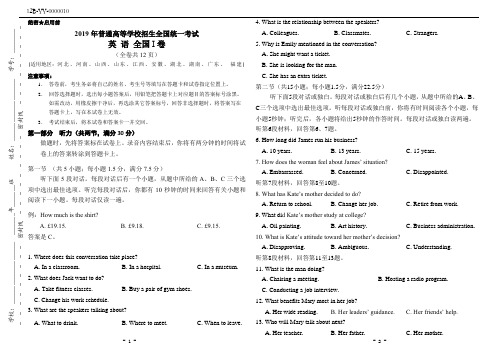
学校:____________________ _______年_______班 姓名:____________________ 学号:________- - - - - - - - - 密封线 - - - - - - - - - 密封线 - - - - - - - - -绝密★启用前2019年普通高等学校招生全国统一考试英 语 全国I 卷(全卷共12页)(适用地区:河北、河南、山西、山东、江西、安徽、湖北、湖南、广东、 福建) 注意事项:1.答卷前,考生务必将自己的姓名、考生号等填写在答题卡和试卷指定位置上。
2. 回答选择题时,选出每小题答案后,用铅笔把答题卡上对应题目的答案标号涂黑。
如需改动,用橡皮擦干净后,再选涂其它答案标号,回答非选择题时,将答案写在答题卡上,写在本试卷上无效。
3.考试结束后,将本试卷和答案卡一并交回。
第一部分 听力(共两节,满分30分)做题时,先将答案标在试卷上。
录音内容结束后,你将有两分钟的时间将试卷上的答案转涂到答题卡上。
第一节 (共5小题;每小题1.5分,满分7.5分)听下面5段对话。
每段对话后有一个小题,从题中所给的A 、B 、C 三个选项中选出最佳选项。
听完每段对话后,你都有10秒钟的时间来回答有关小题和阅读下一小题。
每段对话仅读一遍。
例:How much is the shirt?A. £19.15.B. £9.18.C. £9.15.答案是C 。
1. Where does this conversation take place? A. In a classroom. B. In a hospital.C. In a museum.2. What does Jack want to do?A. Take fitness classes.B. Buy a pair of gym shoes.C. Change his work schedule. 3. What are the speakers talking about? A. What to drink.B. Where to meet.C. When to leave.4. What is the relationship between the speakers?A. Colleagues.B. Classmates.C. Strangers.5. Why is Emily mentioned in the conversation? A. She might want a ticket.B. She is looking for the man.C. She has an extra ticket.第二节(共15小题;每小题1.5分,满分22.5分)听下面5段对话或独白。
2019年高考英语全国1卷(附答案)
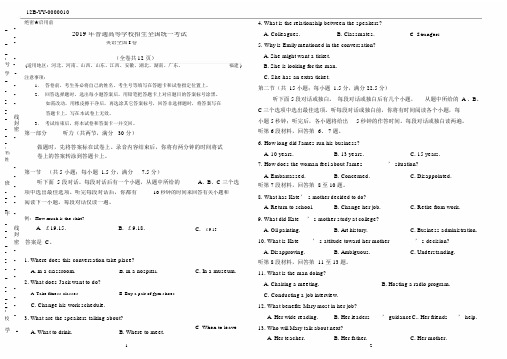
12B-YY-0000010-绝密★启用前__2019 年普通高等学校招生全国统一考试_-__-英语全国I卷__-(全卷共12 页):号 -(适用地区:河北、河南、山西、山东、江西、安徽、湖北、湖南、广东、福建 )学-注意事项:__-1.答卷前,考生务必将自己的姓名、考生号等填写在答题卡和试卷指定位置上。
___-2.回答选择题时,选出每小题答案后,用铅笔把答题卡上对应题目的答案标号涂黑。
___-如需改动,用橡皮擦干净后,再选涂其它答案标号,回答非选择题时,将答案写在___答题卡上,写在本试卷上无效。
_线__封3.考试结束后,将本试卷和答案卡一并交回。
__密_第一部分听力(共两节,满分 30 分)_-__做题时,先将答案标在试卷上。
录音内容结束后,你将有两分钟的时间将试:-名卷上的答案转涂到答题卡上。
姓--第一节(共 5 小题;每小题 1.5 分,满分7.5 分)-听下面 5 段对话。
每段对话后有一个小题,从题中所给的A、B、C 三个选班-__项中选出最佳选项。
听完每段对话后,你都有10 秒钟的时间来回答有关小题和_-__-阅读下一小题。
每段对话仅读一遍。
__4. What is the relationship between the speakers?A. Colleagues.B. Classmates.C. Strangers.5.Why is Emily mentioned in the conversation?A.She might want a ticket.B.She is looking for the man.C.She has an extra ticket.第二节(共 15小题;每小题 1.5分,满分 22.5分)听下面 5段对话或独白。
每段对话或独白后有几个小题,从题中所给的 A 、B、C三个选项中选出最佳选项。
听每段对话或独白前,你将有时间阅读各个小题,每小题 5秒钟;听完后,各小题将给出5秒钟的作答时间。
河北省2019年高考英语试题及答案汇总(word版)(最新)
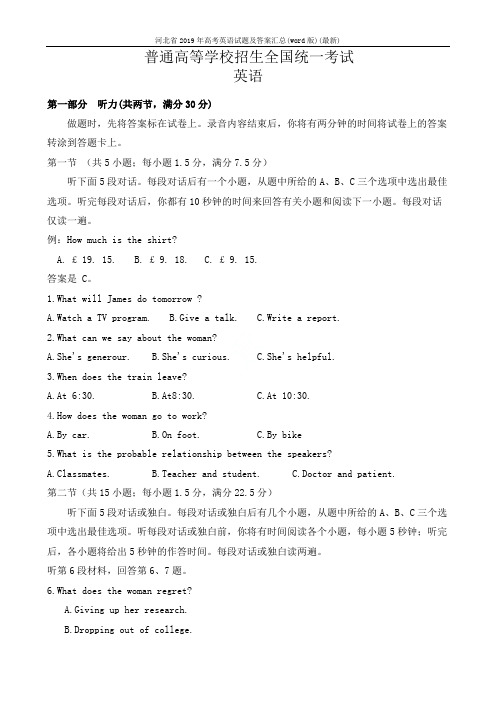
普通高等学校招生全国统一考试英语第一部分听力(共两节,满分30分)做题时,先将答案标在试卷上。
录音内容结束后,你将有两分钟的时间将试卷上的答案转涂到答题卡上。
第一节(共5小题;每小题1.5分,满分7.5分)听下面5段对话。
每段对话后有一个小题,从题中所给的A、B、C三个选项中选出最佳选项。
听完每段对话后,你都有10秒钟的时间来回答有关小题和阅读下一小题。
每段对话仅读一遍。
例:How much is the shirt?A. £ 19. 15.B. £ 9. 18.C. £ 9. 15.答案是 C。
1.What will James do tomorrow ?A.Watch a TV program.B.Give a talk.C.Write a report.2.What can we say about the woman?A.She's generour.B.She's curious.C.She's helpful.3.When does the train leave?A.At 6:30.B.At8:30.C.At 10:30.4.How does the woman go to work?A.By car.B.On foot.C.By bike5.What is the probable relationship between the speakers?A.Classmates.B.Teacher and student.C.Doctor and patient.第二节(共15小题;每小题1.5分,满分22.5分)听下面5段对话或独白。
每段对话或独白后有几个小题,从题中所给的A、B、C三个选项中选出最佳选项。
听每段对话或独白前,你将有时间阅读各个小题,每小题5秒钟;听完后,各小题将给出5秒钟的作答时间。
每段对话或独白读两遍。
听第6段材料,回答第6、7题。
(完整版)2019年高考英语全国3卷(含答案)
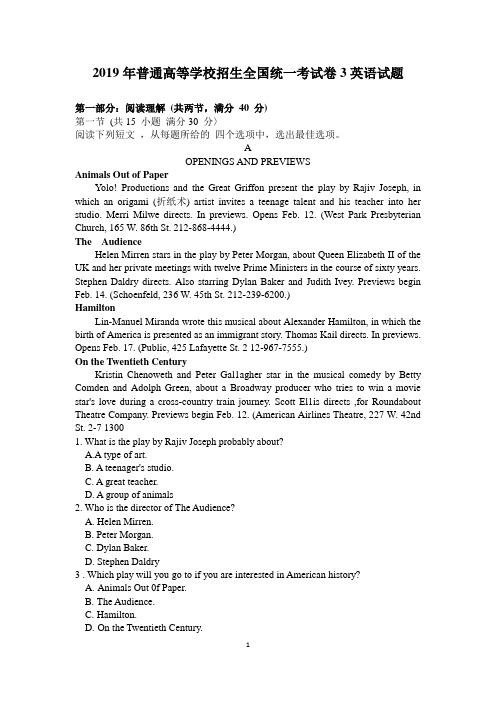
2019年普通高等学校招生全国统一考试卷3英语试题第一部分:阅读理解(共两节,满分40 分)第一节(共15 小题满分30 分〉阅读下列短文,从每题所给的四个选项中,选出最佳选项。
AOPENINGS AND PREVIEWSAnimals Out of PaperYolo! Productions and the Great Griffon present the play by Rajiv Joseph, in which an origami (折纸术) artist invites a teenage talent and his teacher into her studio. Merri Milwe directs. In previews. Opens Feb. 12. (West Park Presbyterian Church, 165 W. 86th St. 212-868-4444.)The AudienceHelen Mirren stars in the play by Peter Morgan, about Queen Elizabeth II of the UK and her private meetings with twelve Prime Ministers in the course of sixty years. Stephen Daldry directs. Also starring Dylan Baker and Judith Ivey. Previews begin Feb. 14. (Schoenfeld, 236 W. 45th St. 212-239-6200.)HamiltonLin-Manuel Miranda wrote this musical about Alexander Hamilton, in which the birth of America is presented as an immigrant story. Thomas Kail directs. In previews. Opens Feb. 17. (Public, 425 Lafayette St. 2 12-967-7555.)On the Twentieth CenturyKristin Chenoweth and Peter Gal1agher star in the musical comedy by Betty Comden and Adolph Green, about a Broadway producer who tries to win a movie star's love during a cross-country train journey. Scott El1is directs ,for Roundabout Theatre Company. Previews begin Feb. 12. (American Airlines Theatre, 227 W. 42nd St. 2-7 13001. What is the play by Rajiv Joseph probably about?A.A type of art.B. A teenager's studio.C. A great teacher.D. A group of animals2. Who is the director of The Audience?A. Helen Mirren.B. Peter Morgan.C. Dylan Baker.D. Stephen Daldry3 . Which play will you go to if you are interested in American history?A.Animals Out 0f Paper.B.The Audience.C.Hamilton.D.On the Twentieth Century.For Western designers, China and its rich culture have long been an inspiration for Western creative"It's no secret that China has always been a source(来源) of inspiration for designers," says Amanda Hil1, chief creative officer at A+E Networks, a global media company and home to some of the biggest fashion (时尚) shows. Earlier this year, the China Through A Looking Glass exhibition in New York exhibited 140 pieces of China-inspired fashionable c10thing alongside Chinese works of art, with the aim of exploring the influence of Chineseaesthetics 美学on Western fashion and how China has fueled the fashionable imagination for centuries. The exhibition had record attendance, showing that there is huge interest in Chinese influences. "China is impossible to overlook," says Hill. "Chinese models are the faces of beauty and fashion campaigns that sell dreams to women all over the world, which means Chinese women are not just consumers of fashion - they are central to its movement." Of course, not only are today's top Western designers being influenced by China - some of the best designers of contemporary fashion are themselves Chinese. "Vera Wang, Alexander Wang, Jason Wu are taking on Galliano, Albaz, Marc Jacobs - and beating them hands down in design and sales," adds Hill.For Hill, it is impossible not to talk about China as the leading player when discussing fashion. "The most famous designers are Chinese, so are the models, and so are the consumers," she says. "China is no longer just another market; in many senses it has become the market. If you talk about fashion today, you are talking about China its influences, its direction, its breathtaking c1othes, and how young designers and models are finally acknowledging that in many ways."4. What can we learn about the exhibition in York?A. It promoted the sales of artworks.B. It attracted a large number of visitors.C. It showed ancient Chinese c1othes.D. It aimed to introduce Chinese models.5. What does HiIl say about Chinese women?A. They are setting the fashion.B. They start many fashion campaigns.C. They admire super models.D. They do business all over the world6. What do the underlined words "taking on" in paragraph 4 mean?A. learning fromB. looking down onC. working withD. competing against7. What can be a suitable title for the text?A. Young Models Selling Dreams to the WorldB. A Chinese Art Exhibition Held in New YorkC. Differences Between Eastern and Western AestheticsD. Chinese Culture Fueling International Fashion TrendsBefore he 1830s,most newspapers were sold through annual subscriptions in America, usually $8 to $ 10 a year. Today $8 0 1' $10 seems a small amount of money, but at that time these amounts were forbidding to most citizens. Accordingly, newspapers were read almost only by rich people in politics or the trades. In addition, most newspapers had little in them that would appeal to a mass audience. They were dull and visually forbidding. But the revolution that was taking place in the 1830s would change all thatThe trend, then, was toward the "penny paper" - a term referring to papers made widely available to the public. It meant any inexpensive newspaper; perhaps more importantly it meant newspapers that could be bought in single copies on the street.This development did not take place ,overnight. It had been possible (but not easy) to buy single copies of newspapers before 1830, but this usually meant the reader had to go down to the printer's office to purchase a copy. Street sales were almost unknown. However, within a few years, street sales of newspapers would be commonplace in eastern cities. At first the price of single copies was seldom a penny - usually two or three cents was charged - and some of the older well-known papers charged five or six cents. But the phrase "penny paper" caught the public's fancy, and soon there would be papers that did indeed sell for only a penny.This new trend of newspapers for "the man on the street" did not begin well. Some of the early ventures (企业)were immediate failures. Publishers already in business, people who were owners of successful papers, had little desire to change the tradition. It took a few youthful and daring businessmen to get the ball rolling8. Which of the following best describes newspapers in America before the 1830sA. Academic.B. Unattractive.C. Inexpensive.D. Confidential9. What did street sales mean to newspapers?A. They would be priced higher.B. They would disappear from cities.C. They could have more readers.D. They could regain public trust.10. Who were the newspapers of the new trend targeted at?A. Local politicians.B. Common people.C. Young publishers.D. Rich businessmen.11. What can we say about the birth of the penny paper?A. It was a difficult process.B.It was a temporary success.C. It was a robber of the poor.D. It was a disaster for printers.DMonkeys seem to have a way with numbers.A team of researchers trained three Rhesus monkeys to associate 26 clearly different symbols consisting of numbers and selective letters with 0-25 drops of water or juice as a reward. The researchers then tested how the monkeys combined - or added - the symbols to get the reward.Here's how Harvard Medical School scientist Margaret Livingstone, who led the team, described the experiment: In their cages the monkeys were provided with touch screens. On one part of the screen, a symbol would appear, and on the other side two symbols inside circle were shown. For example, the number 7 would flash on one side of the screen and the other end would have 9 and 8. If the monkeys touched the left side of the screen they would be rewarded with seven drops of water or juice; if they went for the circle, they would be rewarded with the sum of the numbers - 17 in this example.After running hundreds of tests, the researchers noted that the monkeys would go for the higher values more than half the time, indicating that they were performing a calculation, not just memorizing the value of each combination.When the team examined the results of the experiment more closely, they noticed that the monkeys tended to underestimate (低估) a sum compared with a single symbol when the two were close in value - sometimes choosing, for example, a 13 over the sum of 8 and 6. The underestimation was systematic: When adding two numbers, the monkeys always paid attention to the larger of the two, and then added only action (小部分) of the smaller number to it."This indicates that there is a certain way quantity is represented in their brains," Dr. Livingstone says. "But in this experiment what they're doing is paying more attention to the big number than the little one."12. What did the researchers do to the monkeys before testing them?A. They fed them.B. They named them.C. They trained them.D. They measured them.13 . How did the monkeys get their reward in the experiment?A.By drawing a circle.B.By touching a screen.C.By watching videos.D.By mixing two drinks.14. What did Livingstone's team find about the monkeys?A. They could perform basic addition.C. They could memorize numbers easily.B. They could understand simple words.D. They could hold their attention for long.15. ln which section of a newspaper may this text appear?A. Entertainment.B. Health.C. Education.D. Science.第二节(共5小题: 每小题2分,满分10 分)根据短文内容,从短文后的选项中选出能填入空白处的最佳选项。
2019年全国统一高考英语试卷(新课标I)Word经典高清版本
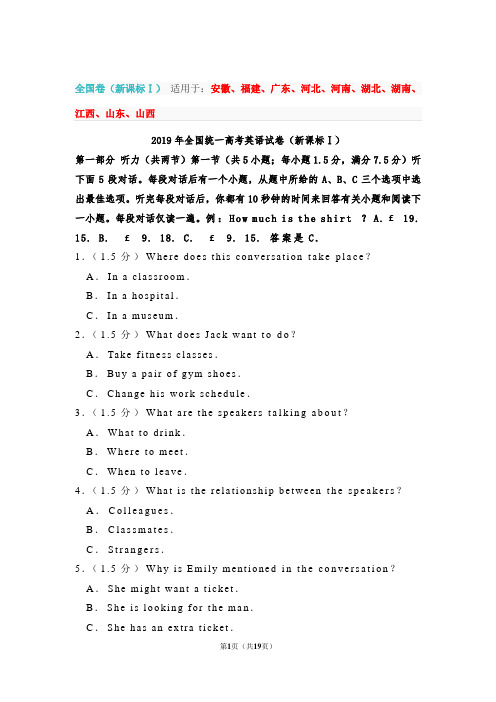
全国卷(新课标Ⅰ)适用于:安徽、福建、广东、河北、河南、湖北、湖南、江西、山东、山西2019年全国统一高考英语试卷(新课标Ⅰ)第一部分听力(共两节)第一节(共5小题;每小题1.5分,满分7.5分)听下面5段对话。
每段对话后有一个小题,从题中所给的A、B、C三个选项中选出最佳选项。
听完每段对话后,你都有10秒钟的时间来回答有关小题和阅读下一小题。
每段对话仅读一遍。
例:H o w m u c h i s t h e s h i r t?A. £19.15. B. £ 9. 18. C. £ 9. 15. 答案是C.1.(1.5分)W h e r e d o e s t h i s c o n v e r s a t i o n t a k e p l a c e?A.I n a c l a s s r o o m.B.I n a h o s p i t a l.C.I n a m u s e u m.2.(1.5分)W h a t d o e s J a c k w a n t t o d o?A.Ta k e f i t n e s s c l a s s e s.B.B u y a p a i r o f g ym s h o e s.C.C h a n g e h i s w o r k s c h e d u l e.3.(1.5分)W h a t a r e t h e s p e a k e r s t a l k i n g a b o u t?A.W h a t t o d r i n k.B.W h e r e t o m e e t.C.W h e n t o l e a v e.4.(1.5分)W h a t i s t h e r e l a t i o n s h i p b e t w e e n t h e s p e a k e r s?A.C o l l e a g u e s.B.C l a s s m a t e s.C.S t r a n g e r s.5.(1.5分)W h y i s E m i l y m e n t i o n e d i n t h e c o n v e r s a t i o n?A.S h e m i g h t w a n t a t i c k e t.B.S h e i s l o o k i n g f o r t h e m a n.C.S h e h a s a n e x t r a t i c k e t.第二节(每小题1.5分,满分22.5分)听下面5段对话或独白.每段对话或独白后有几个小题,从题中所给的A、B、C三个选项中选出最佳选项.听每段对话或独白前,你将有时间阅读各个小题,每小题5秒钟;听完后,各小题将给出5秒钟的作答时间.每段对话或独白读两遍.6.(3分)听材料,回答下列问题.(1)How long did James run his business?A.10 years.B.13 years.C.15 years.(2)How does the woman feel about James' situation?A.Embarrassed.B.Concerned.C.Disappointed.7.(4.5分)听材料,回答下列问题.(1)What has Kate's mother decided to do?A.Return to school.B.Change her job.C.Retire from work.(2)What did Kate's mother study at college?A.Oil painting.B.Art history.C.Business administration.(3)What is Kate's attitude toward her mother's decision?A.Disapproving.B.Ambiguous.C.Understanding.8.(4.5分)听材料,回答下列问题.(1)What is the man doing?A.Chairing a meeting.B.Hosting a radio program.C.Conducting a job interview.(2)What benefits Mary most in her job?A.Her wide reading.B.Her leaders' guidance.C.Her friends' help.(3)Who will Mary talk about next?A.Her teacher.B.Her father.C.Her mother.9.(6分)听材料,回答下列问题.(1)Why does the man seldom do exercise?A.He lacks motivation.B.He has a heart problem.C.He works all the time.(2)What does Jacob Sattelmair probably do?A.He's an athlete.B.He's a researcher.C.He's a journalist.(3)Why does the woman speak of a study?A.To encourage the man.B.To recommend an exercise.C.To support her findings.(4)How much time will the man probably spend exercising weekly?A.300 minutes.B.150 minutes.C.75 minutes.10.(4.5分)听材料,回答下列问题.(1)What did the scientists do to the road?A.They repaired it.B.They painted it.C.They blocked it.(2)Why are young birds drawn to the road surface?A.It's warm.B.It's brown.C.It's smooth.(3)What is the purpose of the scientists' experiment?A.To keep the birds there for a whole year.B.To help students study the birds wel l.C.To prevent the birds from being killed.第二部分阅读理解(共两节)第一节(满分30分)阅读下列短文,从每题所给的A、B、C和D四个选项中,选出最佳选项。
2019年河北高考英语试卷及答案(已公布)

2019年河北高考英语试卷及答案(已公布)【导语】2019年河北高考英语试卷及答案已公布,河北高考英语试卷及答案具体如下:
2019年河北高考英语试卷
2019年河北高考英语答案
成绩查询
2019年高考成绩查询一般从6月下旬开始陆续公布,各地成绩查询时间不同,考生可登陆当地教育考试院网站查询高考成绩。
也可进入无忧考网高考成绩查询专题查询,我们会在公布更新各地高考成绩查询时间及方式。
全国2019年高考成绩查询时间及入口专题点击进入
录取分数线
2019年高考录取分数线一般从6月下旬开始陆续公布,各地分数线公布时间不同,可登陆当地教育考试院网站查看高考录取分数线。
也可进入无忧考网高考录取分数线专题查询,我们会在公布更新各地高考录取分数线信息。
全国2019年高考录取分数线专题点击进入。
2019年高考全国Ⅲ卷英语真题(含答案)

2019年普通高等学校招生全国统一考试(全国卷III)英语第一部分听力(共两节,满分30分)做题时,先将答案标在试卷上。
录音内容结束后,你将有两分钟的时间将试卷上的答案转涂到答题卡上。
第一节(共5小题;每小题1.5分,满分7.5分)听下面5段对话。
每段对话后有一个小题,从题中所给的A、B、C三个选项中选出最佳选项。
听完每段对话后,你都有10秒钟的时间来回答有关小题和阅读下一小题。
每段对话仅读一遍。
例:How much is the shirt?A. £19.15.B. £9.18.C. £9.15.答案是C。
第一节(共5小题;每小题1.5分,满分7.5分)听下面5段对话。
每段对话后有一个小题,从题中所给的A、B、C三个选项中选出最佳选项。
听完每段对话后,你都有10秒钟的时间来回答有关小题和阅读下一小题。
每段对话仅读一遍。
例:How much is the shirt?A. £19.15.B. £9.18.C. £9.15.答案是C。
1. Where does the conversation probably take place?A. In a library.B. In a bookstore.C. In a classroom.2. How does the woman feel now?A. Relaxed.B. Excited.C. Tired.3. How much will the man pay?A. $520.B. $80.C. $100.4. What does the man tell Jane to do?A. Postpone his appointment.B. Meet Mr. Douglas.C. Return at 3 o’clock.5. Why would David quit his job?A. To go back to school.B. To start his own firm.C. To work for his friend. 第二节(共15小题;每小题1.5分,满分22.5分)听下面5段对话或独白。
2019年高考全国Ⅰ卷英语真题(含答案)
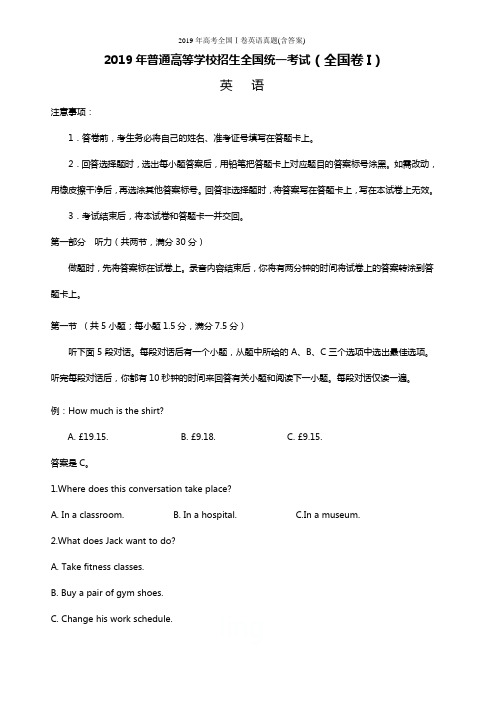
2019年普通高等学校招生全国统一考试(全国卷I)英语注意事项:1.答卷前,考生务必将自己的姓名、准考证号填写在答题卡上。
2.回答选择题时,选出每小题答案后,用铅笔把答题卡上对应题目的答案标号涂黑。
如需改动,用橡皮擦干净后,再选涂其他答案标号。
回答非选择题时,将答案写在答题卡上,写在本试卷上无效。
3.考试结束后,将本试卷和答题卡一并交回。
第一部分听力(共两节,满分30分)做题时,先将答案标在试卷上。
录音内容结束后,你将有两分钟的时间将试卷上的答案转涂到答题卡上。
第一节(共5小题;每小题1.5分,满分7.5分)听下面5段对话。
每段对话后有一个小题,从题中所给的A、B、C三个选项中选出最佳选项。
听完每段对话后,你都有10秒钟的时间来回答有关小题和阅读下一小题。
每段对话仅读一遍。
例:How much is the shirt?A. £19.15.B. £9.18.C. £9.15.答案是C。
1.Where does this conversation take place?A. In a classroom.B. In a hospital.C.In a museum.2.What does Jack want to do?A. Take fitness classes.B. Buy a pair of gym shoes.C. Change his work schedule.3.What are the speakers talking about?A. What to drink.B. Where to meet.C. When to leave.4.What is the relationship between the speakers?A. Colleges.B. Classmates.C. Strangers.5.Why is Emily mentioned in the conversation?A. She might want a ticket.B. She is looking for the man.C. She has an extra ticket.第二节(共15小题,每小题1.5分,满分22.5分)听下面5段对话或独白。
高考英语河北试卷真题

高考英语河北试卷真题2019年高考英语河北卷真题Part I Listening Comprehension (30 marks)Section ADirections: In Section A, you will hear ten short conversations between two speakers. At the end of each conversation, a question will be asked about what was said. The conversations and the questions will be spoken only once. After you hear a conversation and the question about it, read the four possible answers on your paper, and decide which one is the best answer to the question you have heard.1. A. An athlete. B. A traveler. C. A policeman. D. A guard.2. A. At 7:15. B. At 7:30. C. At 7:45. D. At 8:00.3. A. Rainy. B. Cloudy. C. Windy. D. Sunny.4. A. A company party. B. A family gathering. C. A school celebration.D. A small party.5. A. A waitress. B. A visitor. C. A receptionist. D. A travel agent.6. A. It’s in full swing. B. It’s coming to an end.C. It hasn’t started yet. D. It’s been postponed.7. A. 12. B. 23. C. 31. D. 40.8. A. Delighted. B. Surprised. C. Displeased. D. Satisfied.9. A. A book. B. A magazine. C. A report. D. A map.10. A. She’ll check the definition of “scan”. B. She’ll go to administrative office this afternoon. C. She’ll fill out the form for the woman. D. She’ll give a lecture on scanning technology.Section BDirections: In Section B, you will hear two long conversations. At the end of each conversation, you will hear four questions. Both the conversation and the questions will be spoken only once. After you hear a question, read the four possible answers on your paper, and decide which one is the best answer to the question you have heard.Conversation One11. A. Worried. B. Depressed. C. Pleased. D. Amazed.12. A. At the airport. B. At the bus stop. C. At the railway station. D. At the taxi stand.13. A. 6:45. B. 7:05. C. 7:25. D. 7:45.14. A. To queue up to buy some stamps. B. To take a bus to the airport.C. To meet Jane at the supermarket.D. To buy a camera.Conversation Two15. A. In the library. B. In the café. C. In the garden. D. In the restaurant.16. A. 30%. B. 20%. C. 40%. D. 50%.17. A. A designer. B. A photographer. C. An artist. D. A writer.18. A. Body painting. B. Henna tattoo. C. Hand-drawn pottery. D. Watercolor painting.Part II Reading Comprehension (40 marks)Section ADirections: For Questions 19–22, read the following passage and answer the questions.Speech, after all, is a doorway into the world. Every spoken word holds within it the possibility of another world, another version of the speaker. It can tell us not only about the content of thought but also about the thought process itself.19. According to the passage, what can speech do?A. Give us a glimpse into the speaker’s mind.B. Provide us with endless possibilities.C. Present various versions of the speaker.D. Reveal the content of thoughts.20. How does the author view speech?A. As a form of self-expression.B. As a tool for communication.C. As a chance to show off.D. As a barrier to understanding.21. What can be inferred about the author?A. The author is fascinated by written language.B. The author believes in the power of speech.C. The author dislikes talking with people.D. The author is an expert in linguistics.22. What are we told about spoken words in the passage?A. They can transport us to another planet.B. They reveal the speaker’s true intentions.C. They can shed light on the speaker’s inner world.D. They can be used to manipulate others.For Questions 23–26, read the following passage and complete the statements.Teaching machines are everywhere around us but the classroom, where teachers spend every day with the same age group with the same subject is the only place where this technology is not used.23. The passage suggests that teaching machines have been widely used except in ________.24. Teachers often teach students who are the same ________ in the classroom.25. The idea introduces teaching ________ by replacing the traditional forms of teaching.26. People’s attitudes to ________ are changing due to fast developments in the technological industry.Section BDirections: For Questions 27–31, read the following passage and answer the questions.Trapped in our cities, often with only limited access to the natural world, we turn to our pets for a taste of the wild. Or do we? How wild is this so-called wildness?27. What do people generally turn to their pets for, according to the passage?28. What is meant by “this so-called wildness”?29. What is suggested to bring one closer to nature?30. How is the relationship between humans and their pets described in the passage?31. What is implied in the passage about people living in cities?Section CDirections: For Questions 32–35, read the following passage and answer the questions.People love making comparisons between sports and life. I often spend my weekends in the pool, and while swimming, I notice how life’s a lot like swimming.32. What is often compared by people in the passage?33. According to the author, what is swimming a lot like?34. What does the author do on weekends?35. What can be inferred about the author from the passage?Part III Writing (30 marks)Directions: For this part, you are allowed 30 minutes to write an essay commenting on the saying “Never put off until tomorrow what can be done today.” You can cite examples to illustrate your views. You should writ e at least 150 words but no more than 200 words.2019年高考英语河北卷真题结束以上是2019年高考英语河北卷的听力、阅读和写作部分。
2019年高考英语全国3卷(含答案)
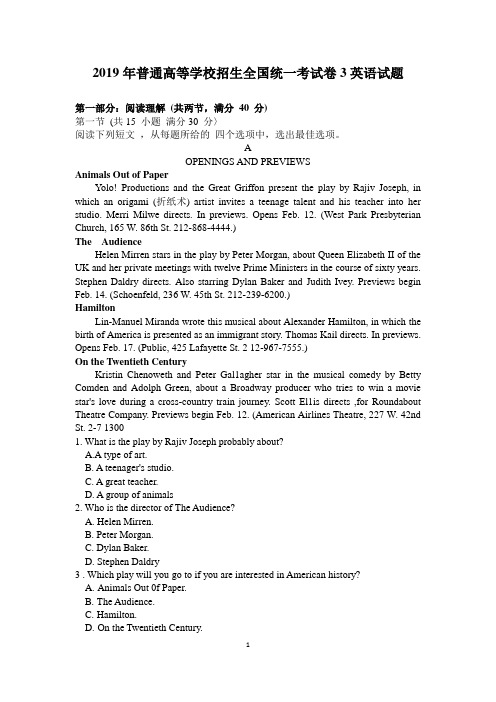
2019年普通高等学校招生全国统一考试卷3英语试题第一部分:阅读理解(共两节,满分40 分)第一节(共15 小题满分30 分〉阅读下列短文,从每题所给的四个选项中,选出最佳选项。
AOPENINGS AND PREVIEWSAnimals Out of PaperYolo! Productions and the Great Griffon present the play by Rajiv Joseph, in which an origami (折纸术) artist invites a teenage talent and his teacher into her studio. Merri Milwe directs. In previews. Opens Feb. 12. (West Park Presbyterian Church, 165 W. 86th St. 212-868-4444.)The AudienceHelen Mirren stars in the play by Peter Morgan, about Queen Elizabeth II of the UK and her private meetings with twelve Prime Ministers in the course of sixty years. Stephen Daldry directs. Also starring Dylan Baker and Judith Ivey. Previews begin Feb. 14. (Schoenfeld, 236 W. 45th St. 212-239-6200.)HamiltonLin-Manuel Miranda wrote this musical about Alexander Hamilton, in which the birth of America is presented as an immigrant story. Thomas Kail directs. In previews. Opens Feb. 17. (Public, 425 Lafayette St. 2 12-967-7555.)On the Twentieth CenturyKristin Chenoweth and Peter Gal1agher star in the musical comedy by Betty Comden and Adolph Green, about a Broadway producer who tries to win a movie star's love during a cross-country train journey. Scott El1is directs ,for Roundabout Theatre Company. Previews begin Feb. 12. (American Airlines Theatre, 227 W. 42nd St. 2-7 13001. What is the play by Rajiv Joseph probably about?A.A type of art.B. A teenager's studio.C. A great teacher.D. A group of animals2. Who is the director of The Audience?A. Helen Mirren.B. Peter Morgan.C. Dylan Baker.D. Stephen Daldry3 . Which play will you go to if you are interested in American history?A.Animals Out 0f Paper.B.The Audience.C.Hamilton.D.On the Twentieth Century.For Western designers, China and its rich culture have long been an inspiration for Western creative"It's no secret that China has always been a source(来源) of inspiration for designers," says Amanda Hil1, chief creative officer at A+E Networks, a global media company and home to some of the biggest fashion (时尚) shows. Earlier this year, the China Through A Looking Glass exhibition in New York exhibited 140 pieces of China-inspired fashionable c10thing alongside Chinese works of art, with the aim of exploring the influence of Chineseaesthetics 美学on Western fashion and how China has fueled the fashionable imagination for centuries. The exhibition had record attendance, showing that there is huge interest in Chinese influences. "China is impossible to overlook," says Hill. "Chinese models are the faces of beauty and fashion campaigns that sell dreams to women all over the world, which means Chinese women are not just consumers of fashion - they are central to its movement." Of course, not only are today's top Western designers being influenced by China - some of the best designers of contemporary fashion are themselves Chinese. "Vera Wang, Alexander Wang, Jason Wu are taking on Galliano, Albaz, Marc Jacobs - and beating them hands down in design and sales," adds Hill.For Hill, it is impossible not to talk about China as the leading player when discussing fashion. "The most famous designers are Chinese, so are the models, and so are the consumers," she says. "China is no longer just another market; in many senses it has become the market. If you talk about fashion today, you are talking about China its influences, its direction, its breathtaking c1othes, and how young designers and models are finally acknowledging that in many ways."4. What can we learn about the exhibition in York?A. It promoted the sales of artworks.B. It attracted a large number of visitors.C. It showed ancient Chinese c1othes.D. It aimed to introduce Chinese models.5. What does HiIl say about Chinese women?A. They are setting the fashion.B. They start many fashion campaigns.C. They admire super models.D. They do business all over the world6. What do the underlined words "taking on" in paragraph 4 mean?A. learning fromB. looking down onC. working withD. competing against7. What can be a suitable title for the text?A. Young Models Selling Dreams to the WorldB. A Chinese Art Exhibition Held in New YorkC. Differences Between Eastern and Western AestheticsD. Chinese Culture Fueling International Fashion TrendsBefore he 1830s,most newspapers were sold through annual subscriptions in America, usually $8 to $ 10 a year. Today $8 0 1' $10 seems a small amount of money, but at that time these amounts were forbidding to most citizens. Accordingly, newspapers were read almost only by rich people in politics or the trades. In addition, most newspapers had little in them that would appeal to a mass audience. They were dull and visually forbidding. But the revolution that was taking place in the 1830s would change all thatThe trend, then, was toward the "penny paper" - a term referring to papers made widely available to the public. It meant any inexpensive newspaper; perhaps more importantly it meant newspapers that could be bought in single copies on the street.This development did not take place ,overnight. It had been possible (but not easy) to buy single copies of newspapers before 1830, but this usually meant the reader had to go down to the printer's office to purchase a copy. Street sales were almost unknown. However, within a few years, street sales of newspapers would be commonplace in eastern cities. At first the price of single copies was seldom a penny - usually two or three cents was charged - and some of the older well-known papers charged five or six cents. But the phrase "penny paper" caught the public's fancy, and soon there would be papers that did indeed sell for only a penny.This new trend of newspapers for "the man on the street" did not begin well. Some of the early ventures (企业)were immediate failures. Publishers already in business, people who were owners of successful papers, had little desire to change the tradition. It took a few youthful and daring businessmen to get the ball rolling8. Which of the following best describes newspapers in America before the 1830sA. Academic.B. Unattractive.C. Inexpensive.D. Confidential9. What did street sales mean to newspapers?A. They would be priced higher.B. They would disappear from cities.C. They could have more readers.D. They could regain public trust.10. Who were the newspapers of the new trend targeted at?A. Local politicians.B. Common people.C. Young publishers.D. Rich businessmen.11. What can we say about the birth of the penny paper?A. It was a difficult process.B.It was a temporary success.C. It was a robber of the poor.D. It was a disaster for printers.DMonkeys seem to have a way with numbers.A team of researchers trained three Rhesus monkeys to associate 26 clearly different symbols consisting of numbers and selective letters with 0-25 drops of water or juice as a reward. The researchers then tested how the monkeys combined - or added - the symbols to get the reward.Here's how Harvard Medical School scientist Margaret Livingstone, who led the team, described the experiment: In their cages the monkeys were provided with touch screens. On one part of the screen, a symbol would appear, and on the other side two symbols inside circle were shown. For example, the number 7 would flash on one side of the screen and the other end would have 9 and 8. If the monkeys touched the left side of the screen they would be rewarded with seven drops of water or juice; if they went for the circle, they would be rewarded with the sum of the numbers - 17 in this example.After running hundreds of tests, the researchers noted that the monkeys would go for the higher values more than half the time, indicating that they were performing a calculation, not just memorizing the value of each combination.When the team examined the results of the experiment more closely, they noticed that the monkeys tended to underestimate (低估) a sum compared with a single symbol when the two were close in value - sometimes choosing, for example, a 13 over the sum of 8 and 6. The underestimation was systematic: When adding two numbers, the monkeys always paid attention to the larger of the two, and then added only action (小部分) of the smaller number to it."This indicates that there is a certain way quantity is represented in their brains," Dr. Livingstone says. "But in this experiment what they're doing is paying more attention to the big number than the little one."12. What did the researchers do to the monkeys before testing them?A. They fed them.B. They named them.C. They trained them.D. They measured them.13 . How did the monkeys get their reward in the experiment?A.By drawing a circle.B.By touching a screen.C.By watching videos.D.By mixing two drinks.14. What did Livingstone's team find about the monkeys?A. They could perform basic addition.C. They could memorize numbers easily.B. They could understand simple words.D. They could hold their attention for long.15. ln which section of a newspaper may this text appear?A. Entertainment.B. Health.C. Education.D. Science.第二节(共5小题: 每小题2分,满分10 分)根据短文内容,从短文后的选项中选出能填入空白处的最佳选项。
2019年英语高考第一卷
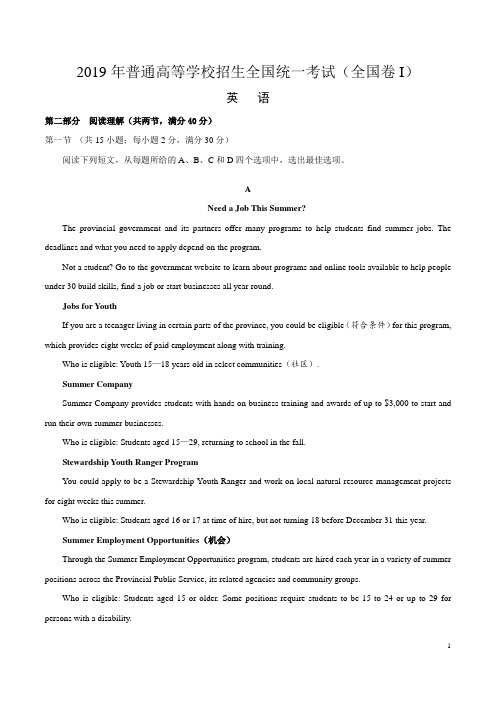
2019年普通高等学校招生全国统一考试(全国卷I)英语第二部分阅读理解(共两节,满分40分)第一节(共15小题;每小题2分,满分30分)阅读下列短文,从每题所给的A、B、C和D四个选项中,选出最佳选项。
ANeed a Job This Summer?The provincial government and its partners offer many programs to help students find summer jobs. The deadlines and what you need to apply depend on the program.Not a student? Go to the government website to learn about programs and online tools available to help people under 30 build skills, find a job or start businesses all year round.Jobs for YouthIf you are a teenager living in certain parts of the province, you could be eligible(符合条件)for this program, which provides eight weeks of paid employment along with training.Who is eligible: Youth 15—18 years old in select communities(社区).Summer CompanySummer Company provides students with hands-on business training and awards of up to $3,000 to start and run their own summer businesses.Who is eligible: Students aged 15—29, returning to school in the fall.Stewardship Youth Ranger ProgramYou could apply to be a Stewardship Youth Ranger and work on local natural resource management projects for eight weeks this summer.Who is eligible: Students aged 16 or 17 at time of hire, but not turning 18 before December 31 this year.Summer Employment Opportunities(机会)Through the Summer Employment Opportunities program, students are hired each year in a variety of summer positions across the Provincial Public Service, its related agencies and community groups.Who is eligible: Students aged 15 or older. Some positions require students to be 15 to 24 or up to 29 for persons with a disability.21. What is special about Summer Company?A. It requires no training before employment.B. It provides awards for running new businesses.C. It allows one to work in the natural environment.D. It offers more summer job opportunities.22. What is the age range required by Stewardship Youth Ranger Program?A.15—18.B.15—24.C.15—29.D.16—17.23. Which program favors the disabled?A. Jobs for Youth.B. Summer Company.C. Stewardship Youth Ranger Program.D. Summer Employment Opportunities.BFor Canaan Elementary’s second grade in Patchogue, N.Y.,today is speech day, and right now it’s Chris Palaez’s turn. The 8-year-old is the joker of the class. With shining dark eyes, he seems like the kind of kid who would enjoy public speaking.But he’s nervous."I’m here to tell you today why you should … should…"Chris trips on the"-ld,"a pronunciation difficulty for many non-native English speakers. His teacher, Thomas Whaley, is next to him, whispering support."…Vo te for …me…"Except for some stumbles, Chris is doing amazingly well. When he brings his speech to a nice conclusion, Whaley invites the rest of the class to praise him.A son of immigrants, Chris started learning English a little over three years ago. Whaley recalls(回想起)how at the beginning of the year, when called upon to read, Chris would excuse himself to go to the bathroom.Learning English as a second language can be a painful experience. What you need is a great teacher who lets you make mistakes. "It takes a lot for any student,"Whaley explains, "especially for a student who is learning English as their new language, to feel confident enough to say, ‘I don’t know,but I want to know.’"Whaley got the idea of this second-grade presidential campaign project when he asked the children one day to raise their hands if they thought they could never be a president. The answer broke his heart. Whaley says the project is about more than just learning to read and speak in public. He wants these kids to learn to boast(夸耀)about themselves."Boasting about yourself, and your best qualities,"Whaley says, "is very difficult for a child who came into the classroom not feeling confident."24. What made Chris nervous?A. Telling a story.B. Making a speech.C. Taking a test.D. Answering a question.25. What does the underlined word "stumbles"in paragraph 2 refer to?A. Improper pauses.B. Bad manners.C. Spelling mistakes.D. Silly jokes.26. We can in fer that the purpose of Whaley’s project is to _________.A. help students see their own strengthsB. assess students’ public speaking skillsC. prepare students for their future jobsD. inspire students’ love for politics27. Which of the following best describes Whaley as a teacher?A. Humorous.B. Ambitious.C. Caring.D. Demanding.CAs data and identity theft becomes more and more common, the market is growing for biometric(生物测量)technologies—like fingerprint scans—to keep others out of private e-spaces. At present, these technologies are still expensive, though.Researchers from Georgia Tech say that they have come up with a low-cost device(装置)that gets around this problem: a smart keyboard. This smart keyboard precisely measures the cadence(节奏)with which one types and the pressure fingers apply to each key. The keyboard could offer a strong layer of security by analyzing things like the force of a user’s typing and the time between key presses. These patterns are unique to each person. Thus, the keyboard can determine people’s identities, and by extension, whether they should be given access to the computer it’s connected to—regardless of whether someone gets the password right.It also doesn’t require a new type of technology that people aren’t already familiar with. Everybody uses a keyboard and everybody types differently.In a study describing the technology, the researchers had 100 volunteers type the word "touch"four times using the smart keyboard. Data collected from the device could be used to recognize different participants based on how they typed, with very low error rates. The researchers say that the keyboard should be pretty straightforward to commercialize and is mostly made of inexpensive, plastic-like parts. The team hopes to make it to market in the near future.28. Why do the researchers develop the smart keyboard?A. To reduce pressure on keys.B. To improve accuracy in typingC. To replace the password system.D. To cut the cost of e-space protection.29. What makes the invention of the smart keyboard possible?A. Computers are much easier to operate.B. Fingerprint scanning techniques develop fast.C. Typing patterns vary from person to person.D. Data security measures are guaranteed.30. What do the researchers expect of the smart keyboard?A. It’ll be environment-friendly.B. It’ll reach consumers soon.C. It’ll be made of plastics.D. It’ll help speed up typing.31. Where is this text most likely from?A. A diary.B. A guidebookC. A novel.D. A magazine.DDuring the rosy years of elementary school(小学), I enjoyed sharing my dolls and jokes, which allowed me to keep my high social status. I was the queen of the playground. Then came my tweens and teens, and mean girls and cool kids. They rose in the ranks not by being friendly but by smoking cigarettes, breaking rules and playing jokes on others, among whom I soon found myself.Popularity is a well-explored subject in social psychology. Mitch Prinstein, a professor of clinical psychology sorts the popular into two categories: the likable and the status seekers. The likables’plays-well-with-others qualities strengthen schoolyard friendships, jump-start interpersonal skills and, when tapped early, are employed ever after in life and work. Then there’s the kind of popularity that appears in adolescence: status born of power and even dishonorable behavior.Enviable as the cool kids may have seemed, Dr. Prinstein’s studies show unpleasant consequence s. Those who were highest in status in high school, as well as those least liked in elementary school, are "most likely to engage (从事)in dangerous and risky behavior."In one study, Dr. Prinstein examined the two types of popularity in 235 adolescents, scoring the least liked, the most liked and the highest in status based on student surveys(调查研究). "We found that the least well-liked teens had become more aggressive over time toward their classmates. But so had those who were high in status. It clearly showed that while likability can lead to healthy adjustment, high status has just the opposite effect on us."Dr. Prinstein has also found that the qualities that made the neighbors want you on a play date-sharing, kindness, openness —carry over to later years and make you better able to relate and connect with others.In analyzing his and other research,Dr. Prinstein came to another conclusion: Not only is likability related to positive life outcomes, but it is also responsible for those outcomes, too. "Being liked creates opportunities for learning and for new kinds of life experiences that help somebody gain an advantage, "he said.32. What sort of girl was the author in her early years of elementary school?A. Unkind.B. Lonely.C. Generous.D. Cool.33.What is the second paragraph mainly about?A. The classification of the popular.B. The characteristics of adolescents.C. The importance of interpersonal skills.D. The causes of dishonorable behavior.34. What did Dr. Prinstein’s study find about the most liked kids?A. They appeared to be aggressive.B. They tended to be more adaptable.C. They enjoyed the highest status.D. They performed well academically.35. What is the best title for the text?A. Be Nice—You Won’t Finish LastB. The Higher the Status, the BetterC. Be the Best—You Can Make ItD. More Self-Control, Less Aggressiveness第二节(共5小题;每小题2分,满分10分)根据短文内容,从短文后的选项中选出能填入空白处的最佳选项。
2019年高考真题全国3卷英语(附答案解析)

绝密★启用前2019年普通高等学校招生统一考试英语试题卷(不含听力部分)一、阅读理解OPENINGS AND PREVIEWSAnimals Out of PaperYolo!Productions and the Great Griffon present the play by Rajiv Joseph, in which an origami(折纸术) artist invites a teenage talent and his teacher into her studio. Merri Milwe directs. In previews. Opens Feb. 12. (West Park Presbyterian Church, 165 W. 86th St.212-868-4444.)The AudienceHelen Mirren stars in the play by Peter Morgan, about Queen Elizabeth II of the UK and her private meetings with twelve Prime Ministers in the course of sixty years. Stephen Daldry directs. Also starring Dylan Baker and Judith Ivey. Previews begin Feb. 14.(Schoenfeld, 236 W. 45th St. 212-239-6200.)HamiltonLin-Manuel Miranda wrote this musical about Alexander Hamilton, in which the birth of America is presented as an immigrant story. Thomas Kail directs. In previews. Opens Feb. 17.(Public, 425 Lafayette St. 212-967-7555.)On the Twentieth CenturyKristin Chenoweth and Peter Gallagher star in the musical comedy by Betty Comden and Adolph Green, about a Broadway producer who tries to win a movie star’s love during a cross-country train journey. Scott Ellis directs, for Roundabout Theatre Company. Previews begin Feb. 12.(American Airlines Theatre, 227 W. 42nd St. 212-719-1300.)1.What is the play by Rajiv Joseph probably about?A.A type of art. B.A teenager’s studio.C.A great teacher. D.A group of animals.2.Who is the director of The Audience?A.Helen Mirren. B.Peter Morgan.C.Dylan Baker. D.Stephen Daldry.A.Animals Out of Paper.B.The Audience.C.Hamilton.D.O n the Twentieth Century.For Western designers, China and its rich culture have long been an inspiration for Western creative.“It’s no secret that China has always been a source(来源) of inspiration for designers,” says Amanda Hill, chief creative officer at A+E Networks, a global media company and home to some of the biggest fashion(时尚) shows.Earlier this year, the China Through A Looking Glass exhibition in New York exhibited 140 pieces of China-inspired fashionable clothing alongside Chinese works of art, with the aim of exploring the influence of Chinese aesthetics(美学) on Western fashion and how China has fueled the fashionable imagination for centuries. The exhibition had record attendance, showing that there is huge interest in Chinese influences.“China is impossible to overlook,” says Hill. “Chinese models are the fa ces of beauty and fashion campaigns that sell dreams to women all over the world, which means Chinese women are not just consumers of fashion —they are central to its movement.” Of course, not only are today’s top Western designers being influenced by Chi na—some of the best designers of contemporary fashion are themselves Chinese. “Vera Wang, Alexander Wang, Jason Wu are taking on Galliano, Albaz, Marc Jacobs—and beating them hands down in design and sales,” adds Hill.For Hill, it is impossible not to talk about China as the leading player when discussing fashion. “The most famous designers are Chinese, so are the models, and so are the consumers,” she says. “China is no longer just another market; in many senses it has become the market. If you talk about fashion today, you are talking about China—its influences, its direction, its breathtaking clothes, and how young designers and models are finally acknowledging that in many ways.”4.What can we learn about the exhibition in New York?A.It promoted the sales of artworks. B.It attracted a large number of visitors. C.It showed ancient Chinese clothes. D.It aimed to introduce Chinese models. 5.What does Hill say about Chinese women?A.They are setting the fashion. B.They start many fashion campaigns. C.They admire super models. D.They do business all over the world.6.What do the underlined words “taking on” in paragraph 4 mean?A.learning from B.looking down on C.working with D.competing against7.What can be a suitable title for the text?A.Young Models Selling Dreams to the WorldB.A Chinese Art Exhibition Held in New YorkC.Differences Between Eastern and Western AestheticsD.Chinese Culture Fueling International Fashion TrendsBefore the 1830s, most newspapers were sold through annual subscriptions in America, usually $8 to $10 a year. Today $8 or $10 seems a small amount of money, but at that time these amounts were forbidding to most citizens. Accordingly, newspapers were read almost only by rich people in politics or the trades. In addition, most newspapers had little in them that would appeal to a mass audience. They were dull and visually forbidding. But the revolution that was taking place in the 1830s would change all that.The trend, then, was toward the “penny paper”—a term referring to papers made widely available to the public. It meant any inexpensive newspaper; perhaps more importantly it meant newspapers that could be bought in single copies on the street.This development did not take place overnight. It had been possible(but not easy) to buy single copies of newspapers before 1830, but this usually meant the reader had to go down to the printer’s office to purchase a copy. Street sales were almost unknown. Howev er, within a few years, street sales of newspapers would be commonplace in eastern cities. At first the price of single copies was seldom a penny—usually two or three cents was charged—and some of the older well-known papers charged five or six cents. But the phrase “penny paper” caught the public’s fancy, and soon there would be papers that did indeed sell for only a penny.This new trend of newspapers for “the man on the street” did not begin well. Some of the early ventures(企业) were immediate failures. Publishers already in business, people who were owners of successful papers, had little desire to change the tradition. It took a few youthful and daring businessmen to get the ball rolling.8.Which of the following best describes newspapers in America before the 1830s? A.Academic. B.Unattractive. C.Inexpensive. D.Confidential.9.What did street sales mean to newspapers?A.They would be priced higher. B.They would disappear from cities. C.They could have more readers. D.They could regain public trust. 10.Who were the newspapers of the new trend targeted at?A.Local politicians. B.Common people.C.Young publishers. D.Rich businessmen.11.What can we say about the birth of the penny paper?A.It was a difficult process. B.It was a temporary success.C.It was a robbery of the poor. D.It was a disaster for printers.Monkeys seem to have a way with numbers.A team of researchers trained three Rhesus monkeys to associate 26 clearly different symbols consisting of numbers and selective letters with 0-25 drops of water or juice as a reward. The researchers then tested how the monkeys combined—or added—the symbols to get the reward.Here’s how Harvard Medical School scientist Margaret Livingstone, who led the team, described the experiment: In their cages the monkeys were provided with touch screens. On one part of the screen, a symbol would appear, and on the other side two symbols inside a circle were shown. For example, the number 7 would flash on one side of the screen and the other end would have 9 and 8. If the monkeys touched the left side of the screen they would be rewarded with seven drops of water or juice; if they went for the circle, they would be rewarded with the sum of the numbers—17 in this example.After running hundreds of tests, the researchers noted that the monkeys would go for the higher values more than half the time, indicating that they were performing a calculation, not just memorizing the value of each combination.When the team examined the results of the experiment more closely, they noticed that the monkeys tended to underestimate(低估) a sum compared with a single symbol when the two were close in value—sometimes choosing, for example, a 13 over the sum of 8 and 6. The underestimation was systematic: When adding two numbers, the monkeys always paid attention to the larger of the two, and then added only a fraction(小部分) of the smaller number to it.“This indicates that there is a certain way quantity is represented in their brains, ”Dr.Livingstone says. “But in this experiment what they’re doing is paying more attention to the big number than the little one.”12.What did the researchers do to the monkeys before testing them?A.They fed them. B.They named them.C.They trained them. D.They measured them.13.How did the monkeys get their reward in the experiment?A.By drawing a circle. B.By touching a screen.C.By watching videos. D.By mixing two drinks.14.What did Livingstone’s team find about the monkeys?A.They could perform basic addition. B.They could understand simple words. C.They could memorize numbers easily. D.They could hold their attention for long. 15.In which section of a newspaper may this text appear?A.Entertainment. B.Health. C.Education. D.Science.二、七选五In an online class, developing healthy patterns of communication with professors is very important. 16.While I have only listed two of each, there are obviously many other situations that can arise. Students should be able to extend the logic(逻辑) of each to their particular circumstance.Do’s• 17.Questions about subject content are generally welcomed. Before asking questions about the course design, read the syllabus(教学大纲) and learning management system information to be sure the answer isn’t hiding in plain sight.• Participate in discussion foru ms(论坛), blogs and other open-ended forums for dialogue. 18.Be sure to stay on topic and not offer irrelevant information. Make a point, and make it safe for others to do the same.Don’ts• Don’t share personal information or stories. Professors are not tr ained nurses, financial aid experts or your best friends. If you are in need of a deadline extension, simply explain the situation to the professor. 19.• Don’t openly express annoyance at a professor or class. 20.When a student attacks ais truly a concern about a professor’s professionalism or ability, be sure to use online course evaluations to calmly offer your comments.A.That’s what they are for.B.Turn to an online instructor for help.C.If more information is needed, they will ask.D.Remember that online professors get a lot of emails.E. Below are some common do’s and don’ts for online learners.F. Everyone has taken a not-so-great class at one time or another.G. Ask questions, but make sure they are good, thoughtful questions.三、完形填空The small town of Rjukan in Norway is situated between several mountains and does not get direct sunlight from late September to mid-March- 21 six months out of the year.“Of course, we 22 it when the sun is shining,” says Karin Ro, who works for the town’s tourism office. “We see the sky is 23 , but down in the valley it’s darker —it’s like on a 24 day.”But that 25 when a system of high-tech 26 was introduced to reflect sunlight from neighboring peaks(山峰) into the valley below. Wednesday, residents(居民) of Rjukan 27 their very first ray of winter sunshine: A row of reflective boards on a nearby mountainside were put to 28 . The mirrors are controlled by a computer that 29 them to turn along with the sun throughout the 30 and to close during windy weather. They reflect a concentrated beam(束) of light onto the town’s central 31 , creating an area of sunlight roughly 600 square meters. When the light 32 , Rjukan residents gathered together.“People have been 33 there and standing there and taking 34 of each other,” Ro says. “The town square was totally 35 . I think almost all the people in the town were there.” The 3,500 residents cannot all 36 the sunshine at the same time. 37 , the new light feels like more than enough for the town’s 38 residents.“It’s not very 39 ,” she says, “but it is enoug h when we are 40 .”21.A.only B.obviously C.nearly D.precisely23.A.empty B.blue C.high D.wide 24.A.cloudy B.normal C.different D.warm 25.A.helped B.changed C.happened D.mattered 26.A.computers B.telescopes C.mirrors D.cameras 27.A.remembered B.forecasted C.received D.imagined 28.A.repair B.risk C.rest D.use 29.A.forbids B.directs C.predicts D.follows 30.A.day B.night C.month D.year 31.A.library B.hall C.square D.street 32.A.appeared B.returned C.faded D.stopped 33.A.driving B.hiding C.camping D.sitting 34.A.pictures B.notes C.care D.hold 35.A.new B.full C.flat D.silent 36.A.block B.avoid C.enjoy D.store 37.A.Instead B.However C.Gradually D.Similarly 38.A.nature-loving B.energy-saving C.weather-beaten D.sun-starved 39.A.big B.clear C.cold D.easy 40.A.trying B.waiting C.watching D.sharing四、语法填空阅读下面短文,在空白处填入1个适当的单词或括号内单词的正确形式。
河北省2019年英语高考真题以及答案

绝密★启用前河北省2019年英语高考试卷(含答案)注意事项:1.答卷前,考生务必将自己的姓名、准考证号填写在答题卡上。
2.回答选择题时,选出每小题答案后,用铅笔把答题卡上对应题目的答案标号涂黑。
如需改动,用橡皮擦干净后,再选涂其他答案标号。
回答非选择题时,将答案写在答题卡上,写在本试卷上无效。
3.考试结束后,将本试卷和答题卡一并交回。
第一部分听力(共两节,满分30分)做题时,先将答案标在试卷上。
录音内容结束后,你将有两分钟的时间将试卷上的答案转涂到答题卡上。
第一节(共5小题;每小题1.5分,满分7.5分)听下面5段对话。
每段对话后有一个小题,从题中所给的A、B、C三个选项中选出最佳选项。
听完每段对话后,你都有10秒钟的时间来回答有关小题和阅读下一小题。
每段对话仅读一遍。
例:How much is the shirt?A. £19.15.B. £9.18.C. £9.15.答案是C。
1.Where does this conversation take place?A. In a classroom.B. In a hospital.C.In a museum.2.What does Jack want to do?A. Take fitness classes.B. Buy a pair of gym shoes.C. Change his work schedule.3.What are the speakers talking about?A. What to drink.B. Where to meet.C. When to leave.4.What is the relationship between the speakers?A. Colleges.B. Classmates.C. Strangers.5.Why is Emily mentioned in the conversation?A. She might want a ticket.B. She is looking for the man.C. She has an extra ticket.第二节(共15小题,每小题1.5分,满分22.5分)听下面5段对话或独白。
2019年高考英语全国1卷(附答案)
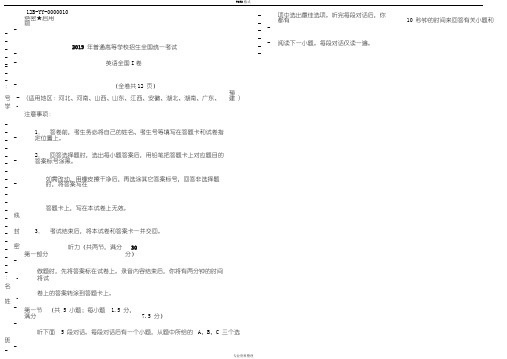
WORD格式12B-YY-0000010- 绝密★启用前__2019 年普通高等学校招生全国统一考试_-__ - 英语全国I卷___- (全卷共12 页):号 - (适用地区:河北、河南、山西、山东、江西、安徽、湖北、湖南、广东、福建 )学-注意事项:__- 1.答卷前,考生务必将自己的姓名、考生号等填写在答题卡和试卷指定位置上。
_ __- 2.回答选择题时,选出每小题答案后,用铅笔把答题卡上对应题目的答案标号涂黑。
_ __- 如需改动,用橡皮擦干净后,再选涂其它答案标号,回答非选择题时,将答案写在___答题卡上,写在本试卷上无效。
_线__封3.考试结束后,将本试卷和答案卡一并交回。
__密_第一部分听力(共两节,满分 30分)_-__ 做题时,先将答案标在试卷上。
录音内容结束后,你将有两分钟的时间将试:-名卷上的答案转涂到答题卡上。
姓-- 第一节(共 5 小题;每小题 1.5 分,满分7.5 分)-听下面 5 段对话。
每段对话后有一个小题,从题中所给的A、B、C 三个选班-_ _ 项中选出最佳选项。
听完每段对话后,你都有10 秒钟的时间来回答有关小题和_-__- 阅读下一小题。
每段对话仅读一遍。
__WORD 格式4. What is the relationship between the speakers?A. Colleagues.B. Classmates.C. Strangers.5.W hy is Emily mentioned in the conversation?A.She might want a ticket.B.She is looking for the man.C.She has an extra ticket.第二节(共 15小题;每小题 1.5分,满分 22.5分)听下面 5段对话或独白。
每段对话或独白后有几个小题,从题中所给的A 、B、C三个选项中选出最佳选项。
听每段对话或独白前,你将有时间阅读各个小题,每小题 5秒钟;听完后,各小题将给出5秒钟的作答时间。
